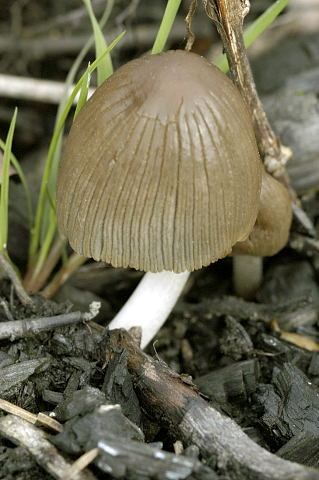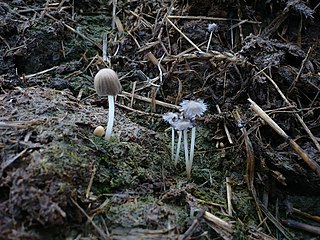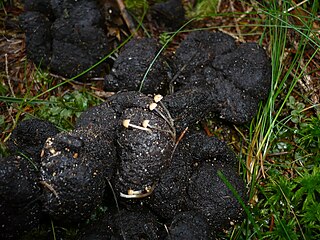Related Research Articles

Coprinellus is a genus of mushroom-forming fungi in the family Psathyrellaceae. The genus was circumscribed by the Finnish mycologist Petter Adolf Karsten in 1879. Most Coprinellus species were transferred from the once large genus Coprinus. Molecular studies published in 2001 redistributed Coprinus species to Psathyrella, or the segregate genera Coprinopsis and Coprinellus.

Tulosesus amphithallus is a species of mushroom producing fungus in the family Psathyrellaceae.

Tulosesus angulatus is a species of mushroom producing fungus in the family Psathyrellaceae.

Tulosesus bisporiger is a species of mushroom producing fungus in the family Psathyrellaceae.

Tulosesus ephemerus is a species of mushroom producing fungus in the family Psathyrellaceae.
Tulosesus callinus is a species of mushroom producing fungus in the family Psathyrellaceae.

Tulosesus bisporus is a species of mushroom producing fungus in the family Psathyrellaceae.
Tulosesus plagioporus is a species of mushroom producing fungus in the family Psathyrellaceae.

Tulosesus pellucidus is a species of mushroom producing fungus in the family Psathyrellaceae.
Tulosesus marculentus is a species of mushroom producing fungus in the family Psathyrellaceae.
Tulosesus hiascens is a species of mushroom producing fungus in the family Psathyrellaceae.
Tulosesus heterosetulosus is a species of mushroom producing fungus in the family Psathyrellaceae.
Tulosesus velatopruinatus is a species of mushroom producing fungus in the family Psathyrellaceae.
Tulosesus subimpatiens is a species of mushroom producing fungus in the family Psathyrellaceae.
Tulosesus subdisseminatus is a species of mushroom producing fungus in the family Psathyrellaceae.
Tulosesus sclerocystidiosus is a species of mushroom producing fungus in the family Psathyrellaceae.
Tulosesus sassii is a species of mushroom producing fungus in the family Psathyrellaceae.

Tulosesus impatiens is a species of fungus in the family Psathyrellaceae. First described in 1821, it has been classified variously in the genera Psathyrella, Pseudocoprinus, Coprinarius, and Coprinus, before molecular phylogenetics reaffirmed it as a Coprinellus species in 2001. The fungus is found in North America and Europe, where the mushrooms grow on the ground in deciduous forests. The fruit bodies have buff caps that are up to 4 cm (1.6 in) in diameter, held by slender whitish stems that can be up to 10 cm (3.9 in) tall. Several other Coprinopsis species that resemble C. impatiens may be distinguished by differences in appearance, habit, or spore morphology.

Parasola auricoma is a species of agaric fungus in the family Psathyrellaceae. First described scientifically in 1886, the species is found in Europe, Japan, and North America. The mushroom was reported in February 2019 in Colombia, in the city of Bogota by the mycologist Juan Camilo Rodriguez Martinez. The small, umbrella-shaped fruit bodies (mushrooms) of the fungus grow in grass or woodchips and are short-lived, usually collapsing with age in a few hours. The caps are up to 6 cm (2.4 in) wide, initially elliptical before flattening out, and colored reddish-brown to greyish, depending on their age and hydration. They are pleated with radial grooves extending from the center to the edge of the cap. The slender, whitish stems are up to 12 cm (4.7 in) long and a few millimeters thick. Microscopically, P. auricoma is characterized by the presence of setae in its cap cuticle. This characteristic, in addition to the relatively large, ellipsoid spores can be used to distinguish it from other morphologically similar Parasola species.
Coprinopsis martinii is a species of mushroom producing fungus in the family Psathyrellaceae.
References
- ↑ "Species Fungorum - Tulosesus subpurpureus (A.H. Sm.) D. Wächt. & A. Melzer, Mycol. Progr. 19(11): 1213 (2020)". www.speciesfungorum.org. Retrieved 2022-07-15.
- 1 2 3 4 Smith AH (1948). "Studies in the dark-spored agarics". Mycologia. 40 (6): 669–707. doi:10.2307/3755317. JSTOR 3755317. PMID 18102857.
- ↑ Redhead SA, Scott A; Vilgalys R; Moncalvo J-M; Johnson J; Hopple JS; Hopple, John S; Johnson, Jacqui; Moncalvo, Jean-Marc; Vilgalys, Rytas (2001). "Coprinus Pers. and the disposition of Coprinus species sensu lato". Taxon. 50 (1): 203–241. doi:10.2307/1224525. JSTOR 1224525.
- ↑ Wächter, Dieter; Melzer, Andreas (2020-11-01). "Proposal for a subdivision of the family Psathyrellaceae based on a taxon-rich phylogenetic analysis with iterative multigene guide tree". Mycological Progress. 19 (11): 1151–1265. doi:10.1007/s11557-020-01606-3. ISSN 1861-8952.